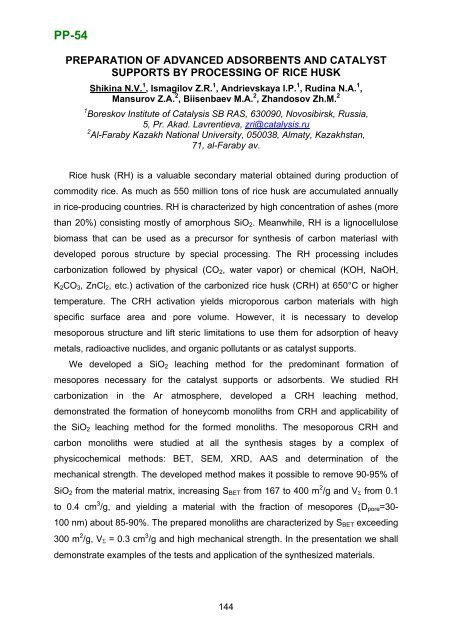Boreskov Institute of Catalysis SB RAS, Novosibirsk, Russia
Boreskov Institute of Catalysis SB RAS, Novosibirsk, Russia
Boreskov Institute of Catalysis SB RAS, Novosibirsk, Russia
- No tags were found...
Create successful ePaper yourself
Turn your PDF publications into a flip-book with our unique Google optimized e-Paper software.
PP-54PREPARATION OF ADVANCED ADSORBENTS AND CATALYSTSUPPORTS BY PROCESSING OF RICE HUSKShikina N.V. 1 , Ismagilov Z.R. 1 , Andrievskaya I.P. 1 , Rudina N.A. 1 ,Mansurov Z.A. 2 , Biisenbaev M.A. 2 , Zhandosov Zh.M. 21 <strong>Boreskov</strong> <strong>Institute</strong> <strong>of</strong> <strong>Catalysis</strong> <strong>SB</strong> <strong>RAS</strong>, 630090, <strong>Novosibirsk</strong>, <strong>Russia</strong>,5, Pr. Akad. Lavrentieva, zri@catalysis.ru2 Al-Faraby Kazakh National University, 050038, Almaty, Kazakhstan,71, al-Faraby av.Rice husk (RH) is a valuable secondary material obtained during production <strong>of</strong>commodity rice. As much as 550 million tons <strong>of</strong> rice husk are accumulated annuallyin rice-producing countries. RH is characterized by high concentration <strong>of</strong> ashes (morethan 20%) consisting mostly <strong>of</strong> amorphous SiO 2 . Meanwhile, RH is a lignocellulosebiomass that can be used as a precursor for synthesis <strong>of</strong> carbon materiasl withdeveloped porous structure by special processing. The RH processing includescarbonization followed by physical (CO 2 , water vapor) or chemical (KOH, NaOH,K 2 CO 3 , ZnCl 2 , etc.) activation <strong>of</strong> the carbonized rice husk (CRH) at 650°C or highertemperature. The CRH activation yields microporous carbon materials with highspecific surface area and pore volume. However, it is necessary to developmesoporous structure and lift steric limitations to use them for adsorption <strong>of</strong> heavymetals, radioactive nuclides, and organic pollutants or as catalyst supports.We developed a SiO 2 leaching method for the predominant formation <strong>of</strong>mesopores necessary for the catalyst supports or adsorbents. We studied RHcarbonization in the Ar atmosphere, developed a CRH leaching method,demonstrated the formation <strong>of</strong> honeycomb monoliths from CRH and applicability <strong>of</strong>the SiO 2 leaching method for the formed monoliths. The mesoporous CRH andcarbon monoliths were studied at all the synthesis stages by a complex <strong>of</strong>physicochemical methods: BET, SEM, XRD, AAS and determination <strong>of</strong> themechanical strength. The developed method makes it possible to remove 90-95% <strong>of</strong>SiO 2 from the material matrix, increasing S BET from 167 to 400 m 2 /g and V Σ from 0.1to 0.4 cm 3 /g, and yielding a material with the fraction <strong>of</strong> mesopores (D pore =30-100 nm) about 85-90%. The prepared monoliths are characterized by S BET exceeding300 m 2 /g, V Σ = 0.3 cm 3 /g and high mechanical strength. In the presentation we shalldemonstrate examples <strong>of</strong> the tests and application <strong>of</strong> the synthesized materials.144
















